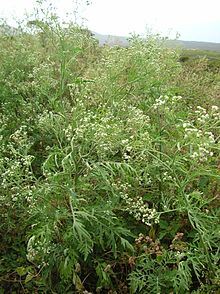- Parthenium
-
Parthenium 
Parthenium hysterophorus Scientific classification Kingdom: Plantae (unranked): Angiosperms (unranked): Eudicots (unranked): Asterids Order: Asterales Family: Asteraceae Subfamily: Asteroideae Tribe: Heliantheae[1] Genus: Parthenium
L.Species See text
Synonyms Parthenium is a genus of flowering plants in the aster family, Asteraceae. The name is derived from either the Greek word παρθένος (parthenos), meaning "virgin," or παρθένιον (parthenion), an ancient name for a plant.[3] Members of the genus are commonly known as feverfew.[4] Notable species include Guayule (P. argentatum) and P. hysterophorus, a serious invasive species in the Old World.[5]
Contents
Uses
In North America, the Jicarilla Apache people used Parthenium incanum for medicine (Opler 1946: 8). The sap of Guayule (P. argentatum) is a source of natural rubber.[6]
Selected species
- Parthenium alpinum (Nutt.) Torr. & A.Gray – Arkansas River Feverfew
- Parthenium argentatum A.Gray – Guayule
- Parthenium bipinnatifidum (Ortega) Rollins
- Parthenium confertum A.Gray – Gray's Feverfew
- Parthenium fruticosum Less.
- Parthenium hispidum Raf.
- Parthenium hysterophorus L. – Santa Maria Feverfew, Whitetop Weed
- Parthenium incanum Kunth – Mariola
- Parthenium integrifolium L. – American Feverfew, Wild Quinine
- Parthenium ligulatum (M.E. Jones) Barneby – Colorado Feverfew
- Parthenium radfordii Mears
- Parthenium schottii Greenm. ex Millsp. & Chase
- Parthenium tomentosum DC.
Gallery
Notes
- ^ "GENUS Parthenium". Taxonomy. UniProt. http://www.uniprot.org/taxonomy/35934. Retrieved 2010-10-29.
- ^ "Genus: Parthenium L.". Germplasm Resources Information Network. United States Department of Agriculture. 1998-09-03. http://www.ars-grin.gov/cgi-bin/npgs/html/genus.pl?8927. Retrieved 2010-10-29.
- ^ Strother, John L.. "Parthenium Linnaeus, Sp. Pl. 2: 988. 1753; Gen. Pl. ed. 5, 426. 1754.". Flora of North America. eFloras.org. http://www.efloras.org/florataxon.aspx?flora_id=1&taxon_id=124104. Retrieved 2011-08-09.
- ^ a b "Parthenium". Integrated Taxonomic Information System. http://www.itis.gov/servlet/SingleRpt/SingleRpt?search_topic=TSN&search_value=38160. Retrieved 2011-08-09.
- ^ "Parthenium hysterophorus (herb)". Global Invasive Species Database. Invasive Species Specialist Group. 2010-10-04. http://www.issg.org/database/species/ecology.asp?fr=1&si=153&sts. Retrieved 2011-08-09.
- ^ Ray, Dennis T. (1993). J. Janick and J.E. Simon. ed. "Guayule: A source of natural rubber". New crops (New York: Wiley): 338–343. http://www.hort.purdue.edu/newcrop/proceedings1993/v2-338.html.
- ^ "GRIN Species Records of Parthenium". Germplasm Resources Information Network. United States Department of Agriculture. http://www.ars-grin.gov/cgi-bin/npgs/html/splist.pl?8927. Retrieved 2010-10-29.
References
- Everitt, J.H.; Lonard, R.L., Little, C.R. (2007). Weeds in South Texas and Northern Mexico. Lubbock: Texas Tech University Press. ISBN 0-89672-614-2
- Opler, Morris E. (1946). Childhood and youth in Jicarilla Apache society. Publications of the Frederick Webb Hodge Anniversary Fund (Vol. 5). Los Angeles: The Southwest Museum Administrator of the Fund.
Categories:- Parthenium
- Asteraceae genera
Wikimedia Foundation. 2010.


